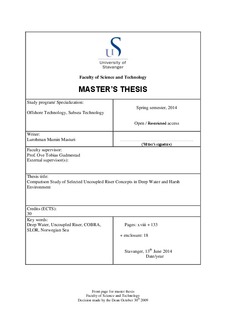| dc.description.abstract | Installing deep water risers in harsh environmental conditions even in the icing environment, in the near future seems like inevitable. Especially in the Norwegian Sea, the development of deep water technology requires an urgent solution of how to transfer hydrocarbons from sea bed to the host facility in a remote area with considering hostile environment conditions.
In every subsea production system combined with a floating facility, the need of risers is a must. Deeper water causes various challenges, for instance; higher payload of the vessel, increase probability of collapse failure of the riser, higher probability for riser failure due to buckling and fatigue issue at the touch-down-point (TDP) as well as presence of Vortex Induce Vibration (VIV) in the long suspended riser span. In addition, the polar climate which is occurring in the Norwegian Sea should be considered during designing, installing and operating of the system which caused this area to be different from other places.
In order to reduce excessive floater motions, an uncoupled riser system is introduced. By using buoy elements, the riser system is able decouple the motion effect of the floater, riser and mooring system that may magnify the extreme hull/floater response. This can significantly improve strength and fatigue performance of the riser. This system is widely used in deep water conditions with various riser configurations. In general, an uncoupled riser system consists of two different types of riser concepts (flexible and steel) with buoy in between. There are three main components in this configuration; a flexible jumper that is directly connected to the floater, a sub-surface buoyancy module at the connection point, and a steel riser at the bottom parts. The flexible jumper is used to absorb the floater motions, and the result the configuration gives the optimum riser concept which is best suited for deep water conditions.
In this topic, we limit the uncoupled riser configurations into two types; Catenary Offset Buoyant Riser Assembly (COBRA) and Single Line Offset Riser (SLOR). The difference between these two riser configurations is at the bottom part and at the connection point; COBRA configures the steel pipe as a catenary riser with a long-slender sub-surface buoyancy module on the top which is tethered down to sea bed via mooring lines while SLOR configures the steel pipe as a tensioned riser by using an air can as a buoyancy module to maintain the riser in tensioned position all time. By means of these riser configurations we have the possibility to use different types of riser arrangements since a standalone flexible riser is very expensive to use in deep water conditions. The main advantage of the two uncoupled riser configurations is that they enable possibilities for the floater to drift/side-step in case of drifting icebergs, which will be one of the study cases.
This thesis focuses on a comparison study of the two uncoupled riser configurations based on ultimate limit state (ULS) and accidental limit state (ALS) results by considering the possibility to avoid/prevent iceberg collision. As explained previously, the risers to be studied are set to be installed in the Norwegian Sea which has harsh environmental conditions. Three different water depths have been chosen on purpose, which are 100m, 400m, and 1500m.
In the event of iceberg approach, this thesis work presents two solutions for comparison study. The two solutions are to drift/side-step the floating structure or to disconnect the riser/mooring system using a disconnectable turret. The repot will suggest the optimum solutions; the most suitable uncoupled riser configuration for the Norwegian Sea condition with respect to the riser performance for the case of floater drift off and the geometry of a disconnected riser.
Based on detail strength analysis in operating and accidental conditions, this thesis concludes that COBRA riser concept has robust and efficient design to install in the Norwegian Sea conditions. In addition, the COBRA configuration in 1500 m water depth is feasible to perform a 250 m side-stepping in the event of an iceberg approach. | nb_NO |
